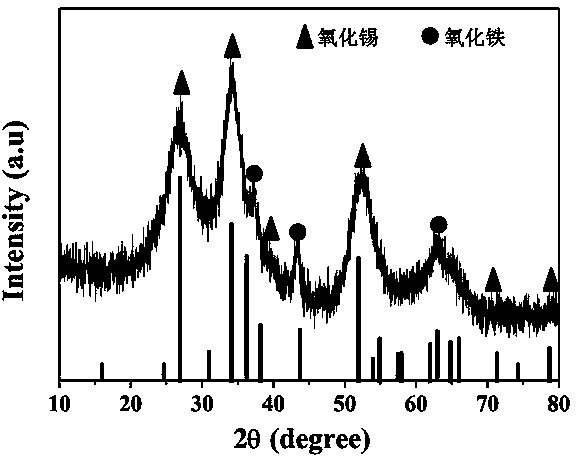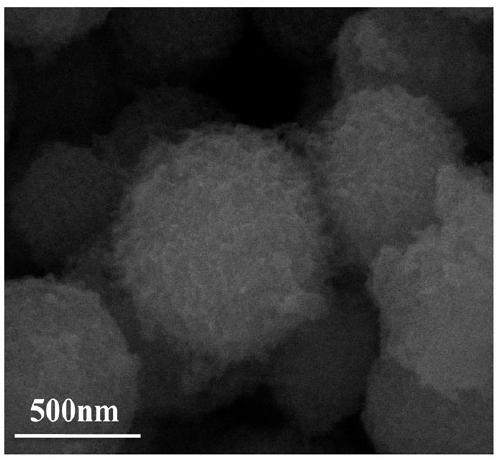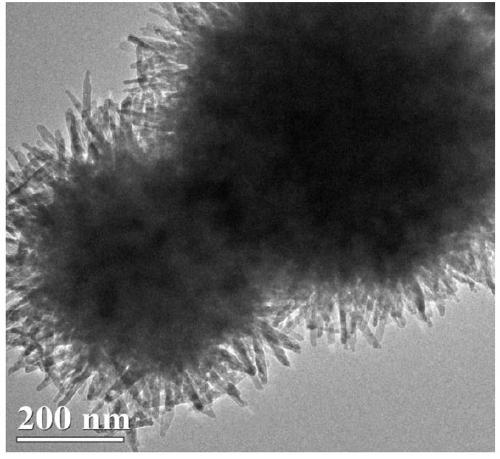Preparation method of three-dimensional hierarchical structure tin oxide microballoon composite ferric oxide nanorod gas sensitive material
A technology of iron oxide nanometer and hierarchical structure, which is applied in the direction of iron oxide, tin oxide, iron oxide/iron hydroxide, etc., and can solve the problems of gas pollution, environmental pollution, social property loss, etc.
- Summary
- Abstract
- Description
- Claims
- Application Information
AI Technical Summary
Problems solved by technology
Method used
Image
Examples
Embodiment 1
[0018] (1) First measure 60 ml of methanol into a beaker, then add a certain amount of tin tetrachloride pentahydrate and polyvinylpyrrolidone (PVP), wherein the concentration of tin tetrachloride pentahydrate is 0.014 mol / L, polyvinylpyrrolidone The concentration of (PVP) is 0.003mol / L, and the molar ratio of controlling tin tetrachloride pentahydrate and polyvinylpyrrolidone (PVP) is 4.7:1;
[0019] (2) Pour the obtained solution into a 100 ml reaction kettle and keep it warm at 160 °C for 2 h; the obtained precipitates were washed three times with deionized water and twice with absolute ethanol (in this process, an ultrasonic cleaner was used to disperse , to reduce the agglomeration of particles);
[0020] (3) Add the centrifuged product obtained in step (2) into deionized water to form a uniform tin hydroxide solution, and calculate the density of the solution for the convenience of the next step;
[0021] (4) Measure 6 ml of tin hydroxide solution (14 mg / ml) in a beaker...
Embodiment 2
[0025] (1) First measure 60 ml of methanol into a beaker, then add a certain amount of tin tetrachloride pentahydrate and polyvinylpyrrolidone (PVP), wherein the concentration of tin tetrachloride pentahydrate is 0.016 mol / L, polyvinylpyrrolidone The concentration of (PVP) is 0.0035mol / L, and the molar ratio of controlling tin tetrachloride pentahydrate and polyvinylpyrrolidone (PVP) is 4.6:1;
[0026] (2) Pour the obtained solution into a 100 ml reaction kettle and incubate at 180 °C for 3 h; the obtained precipitates were washed three times with deionized water and twice with absolute ethanol (in this process, an ultrasonic cleaner was used to disperse , to reduce the agglomeration of particles);
[0027] (3) Add the centrifuged product obtained in step (2) into deionized water to form a uniform tin hydroxide solution, and calculate the density of the solution for the convenience of the next step;
[0028](4) Measure 7 ml of tin hydroxide solution (14 mg / ml) in a beaker, ad...
Embodiment 3
[0032] (1) First measure 60 ml of methanol into a beaker, then add a certain amount of tin tetrachloride pentahydrate and polyvinylpyrrolidone (PVP), wherein the concentration of tin tetrachloride pentahydrate is 0.018 mol / L, polyvinylpyrrolidone The concentration of (PVP) is 0.004mol / L, and the molar ratio of controlling tin tetrachloride pentahydrate and polyvinylpyrrolidone (PVP) is 4.5:1;
[0033] (2) Pour the obtained solution into a 100 ml reaction kettle and incubate at 200 °C for 4 h; the obtained precipitates were washed three times with deionized water and twice with absolute ethanol (in this process, an ultrasonic cleaner was used to disperse , to reduce the agglomeration of particles);
[0034] (3) Add the centrifuged product obtained in step (2) into deionized water to form a uniform tin hydroxide solution, and calculate the density of the solution for the convenience of the next step;
[0035] (4) Measure 8 ml of tin hydroxide solution (14 mg / ml) in a beaker, ad...
PUM
 Login to View More
Login to View More Abstract
Description
Claims
Application Information
 Login to View More
Login to View More - R&D
- Intellectual Property
- Life Sciences
- Materials
- Tech Scout
- Unparalleled Data Quality
- Higher Quality Content
- 60% Fewer Hallucinations
Browse by: Latest US Patents, China's latest patents, Technical Efficacy Thesaurus, Application Domain, Technology Topic, Popular Technical Reports.
© 2025 PatSnap. All rights reserved.Legal|Privacy policy|Modern Slavery Act Transparency Statement|Sitemap|About US| Contact US: help@patsnap.com



